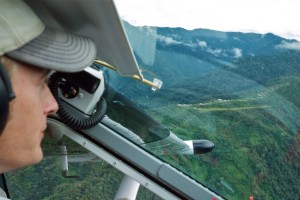 |
| PC-6 training (Nov 2011) |
Super Cub training
Of course it wasn’t to be just a holiday but a chance to get used to flying a tailwheel aircraft. Clacton Aero Club‘s tailwheel conversion course had come highly recommended both from chatting to other pilots and reading about on the internet a bit. So I booked up the full farmstrip special course which would give be a few extra hours doing plenty of take-offs and landings in an aircraft I’d always wanted to try, the Piper PA18 Super Cub.
 |
| Supercub training, UK (Aug 2011) |
What a wonderful aircraft! I’ve never flown anything with quite the same fantastic view from the cockpit and I just loved the central seating position. The Super Cub’s one of those aircraft that has everything you need and nothing more. I love it’s fuel gauges which are either side of your head and show you directly the fuel level in the wing tanks using see-through tubes. I love it’s beautifully harmonised controls that seem to require the minimum of effort to guide the aircraft where you want it to go and I especially love it’s fantastic STOL ability (although my landing’s weren’t especially short I have to admit!).
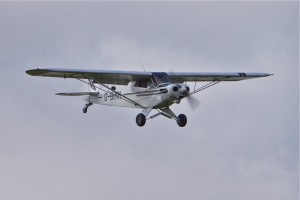 |
| G-BIMM, Piper Super Cub coming into land at Clacton-on-Sea, UK |
The training went well and after three hours of general handling and number of touch and goes, my instructor hopped out from the back and told me to try a circuit on my own. Now, for the last two years I’ve always had someone else in the aircraft with me as our C208s are flown multi-crew, so to be all alone up in the air was almost a unique experience. And I loved it! There’s something very special about flying around on your own. Just you and the machine flirting with the clouds, watching the world below drift by. I just knew I was going to love flying the Porter.
The farmstrip flying bit of the course was a most splendid couple of hours spent flying around the rolling countryside of eastern England, dropping into various small, grass airstrips along the way. I made a short video of it here. Back on the ground, paperwork complete, I was now ready to start learning to fly the Porter.
PC-6 Initial training
Sitting in the left hand seat of a Porter for the first time, parked up in the sweaty, humid heat of a Nabire afternoon, felt pretty alien but also strangely familiar. The Garmin G950 avionics were almost identical to the C208’s G1000 setup bar one less screen and the perfectly placed control stick with adjustable toe brake equipped rudder pedals all felt just right. The start-up procedure is very similar to the C208 too, which isn’t surprising considering they share the same Pratt & Whitney PT6 turbo-prop engine, abet a different variant.
The first thing I noticed was the lack of indent on the power lever for beta propeller pitch; you just bring the lever back to the stop and there’s beta pitch. I’d heard all about the Porter’s ability to engage beta pitch in the air for rapid rates of descent and now I could see how this was easy to do (although there’s a little more to it than just closing the power). The next thing that grabbed me was how heavy the rudder pedals were when taxiing and how you had to use the tow brakes to straighten up a turn, otherwise you did a nice pirouette on the runway as you swung 90 degrees to line up for take-off.
Taxiing issues aside, the take-off was a feet first leap into the affects of p-factor, torque steer and gyroscopic precession all rolled into one. “You’ll need a bit of right rudder for take-off buddy” Sven helpfully reminds me as we roll down the runway and I press my right leg as far into the bulkhead as I can. Blimey, that’s going to take some getting used to I think to myself.
Training mostly consisted of lots of touch-and-goes until I screwed up. Sven was wanting me to land not perfectly straight as on a tarmac runway in a large tailwheel aircraft such as the Porter, that’s where the fun and games begin. The Cub was a lesson in lots of quick, small inputs on the rudders to keep the landing roll straight. In the Porter, if you’re not perfectly straight when you put all three wheels onto the tarmac you’d better be ready with a large stab of opposite rudder and maybe even brakes to get it straight again, unless you fancy a bit of off-roading.
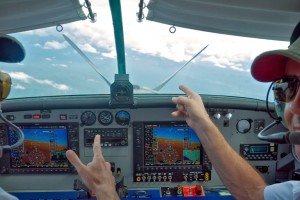 |
| Engine shutdown in flight during PC-6 training (Oct 2011) |
Another important aspect of the training involved shutting the engine down in flight and restarting it. I’d never done such a thing in a single engined aircraft before but it’s a great confidence booster knowing the drills and keeping calm. The silence certainly adds an element of extra pressure to get it all right.
Once all the basics were covered, it was time to go and try a few mountain airstrips. Although I was not going to be flying in the mountains any time soon, it was nice to get some pointers on bush flying from an expert and get a feel for the Porter on rougher airstrips. I had a blast and all too soon was sent solo from Nabire to Biak to drop the aircraft off at maintenance before leaving Papua to begin life as a survey pilot.
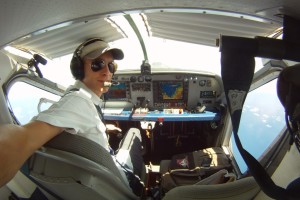 |
| First solo in the PC-6 (Nov 2011) |
PC-6 Survey flying
This was something I knew I’d have to do on the way to being a mountain pilot in Papua and not something I was especially looking forward to. Still, as it was a new skill to learn I jumped in with both feet and got stuck into it. Our company used to contract out one of our PC-6’s for survey operations and the company that hired our aircraft then handled everything apart from aviation side of things. As it was a western company, that meant staying in the nicest hotels available near the survey sights and, smooth efficient transitions from one survey area to the next. As this is Indonesia, you can imagine the paperwork involved with doing a single survey area…
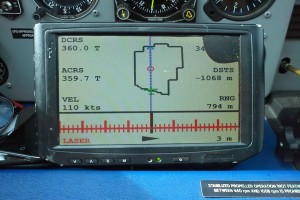 |
| Survey flying (Nov 2011) |
Anyway, the actual flying involved following something very similar to an ILS CDI needle but without the glidepath guidance. However, you did need to maintain a height above the terrain you were surveying as well as a constant groundspeed when on a line. Off a line you can only bank the aircraft 20 degree maximum which made getting off one line and back onto the other rather tricky. I wrote a good introduction to survey flying here.
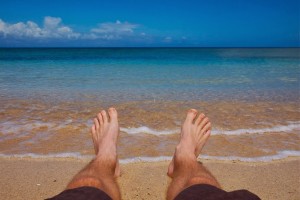 |
| Kisar island survey afternoon off (April 2012) |
Aside from the actual rigours of flying surveys, the places I went to ranged from total s**tholes to 5 star luxury and most things in-between. Occasionally, those really remote surveys did treat me to some of the most amazingly beautiful parts of Indonesia as the survey from Kisar island can testify to. Looking back I guess it wasn’t that bad but ask me how I was after a 6 hour flight, following that screen, being bounced around in the hot, humid air of central Borneo knowing I had rather substandard hotel to retire to, and I’d probably be less enthusiastic about the whole thing.
PC-6 Jungle flying – Malinau, Kalimantan
Moving on from survey I also got to spend a few tours flying from our northern Kalimantan (Borneo) base of Malinau. This was to be the place I’d cut my teeth on proper bush flying and learn a lot of things along the way. Whilst Borneo doesn’t have the mountainous terrain of Papua, there’s still plenty of hills and some of the airstrips are certainly on a par with Papua in places.
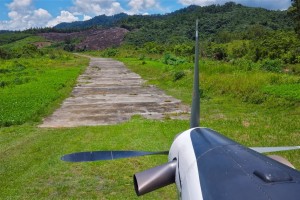 |
| Long Pudjikan, Kalimantan (Aug 2012) |
I loved taking the Porter into the many grass airstrips which were often very wet and muddy which was not something I’d had to do before. We always landed the C208 on boring old tarmac runways or compacted gravel at least. Nothing like a short, narrow and wet airstrip tucked into a valley to focus one’s mind on nailing the landing.
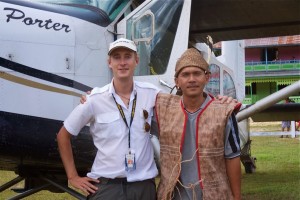 |
| Donny and I in Binuang, Kalimantan (July 2012) |
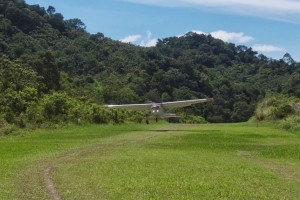 |
| MAF Cessna 206 departing Long Alango, Kalimantan (July 2012) |
Over my tours of Malinau in 2012 I saw and experienced a whole range of different weather phenomena from terrific thunderstorms bringing massive amounts of rain to horrible hazy weeks on end from the locals burning the jungle for their rice fields and palm oil plantations. I also experienced my first ever in-flight emergency as had oil pressure problems en-route forcing me to do a precautionary landing into one of the remote airstrips and overnight.
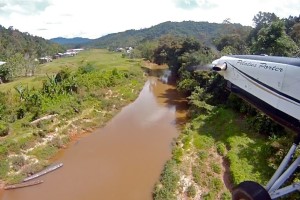 |
| Approach into Pa’Upan, Kalimantan (Feb 2012) |
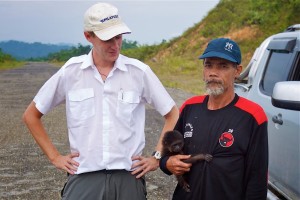 |
| Man and monkey in Mahak Baru, Kalimantan (Oct 2012) |
After nearly a year flying both survey and jungle flying in Malinau, I finally got the call to come back to Papua and be evaluated to see if I’d cut the mustard. I was feeling fairly confident and comfortable flying the Porter but one can never be certain of anything, so I got on that red-eye flight from Jakarta to Nabire hoping I would pass muster and would be able start my new life flying in the mountains of Papua.
PC-6 Mountain flying – Papua
“Is that another new watch?” was pretty much the first thing Sven commented on when we met on the apron of Nabire for my first mountain check flight. It’s well known amongst the pilots here that I’m rather partial to lumps of Swiss metal, and that includes the Porter!
Our first flight into the mountains was to be to Bilogai which is one of the longer, sealed airstrips located towards the end of the Freeway valley running from Nabire in the west to Mulia in the central highlands. That nearly ended in disaster as my slightly non-straight landing and a less than perfectly functioning left-brake pedal, saw us slewing off the right side of the airstrip and nearly into a rather large hole. A stab of power to get some airflow over the rudder brought us back into the middle but scarred the crap out of both of us (as well as the MAF C208 pilot parked up on the right side apron who I saw running for cover as the PC-6 was making a beeline for him!).
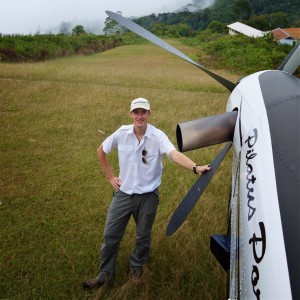 |
| Papua PC-6 mountain checkout complete (Oct 2012) |
Things got considerably better after that fright and after a few days flying into and out of a number of airstrips from Nabire, I was signed off as an official Papua Porter pilot. I think landing at Dadou with it’s 18% average up-slope was one of the many highlights and the grin in the above photo pretty much summed up how I felt about it all. Next stop, Timika for line training!
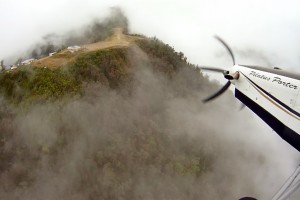 |
| Approach into Tsinga, Papua (Dec 2012) |
Line training consisted of flying into and out of the more common airstrips we go to from Timika with a more experienced Porter pilot in the left seat. Once he was happy with me, I was let loose on my own. I remember my first solo in the mountains of Papua from Timika to Tsinga, just 15 minutes away. It was another one of those pinch myself moments as I’d finally done it. I was now properly flying the Pilatus Porter in the mountains of Papua.
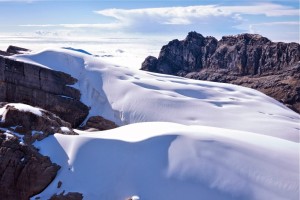 |
| Snow on Puncak Jaya, Papua (Nov 2012) |
Over the next couple of months I flew from our Timika base to help give me both familiarity with the area and the continuity needed to become comfortable with both flying the Porter into mountain airstrips. Landing and taking-off at high altitude is very different to sea-level. The extra groundspeed you have on landing thanks to both the density altitude and tailwinds does take getting used to.
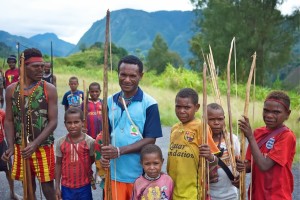 |
| Locals in Bilai, Papua (Jan 2013) |
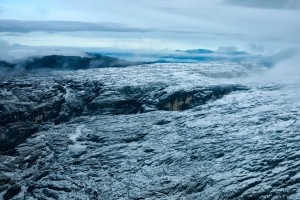 |
| Snow near Puncak Jaya (Jan 2013) |
Upon returning to Papua after my Christmas break I was scheduled to be in Nabire. Now, although I’d done a bit of training out of Nabire, it was not somewhere I’d had a chance to become familiar with yet nor had I been able to fly into all of the airstrips we go to from there. So this was another major part of my learning; self-checking into an airstrip.
To this day, going somewhere new is always exciting to me. Sometimes you have a little chart someone’s drawn up to offer some kind of guidance as to what to expect. Other times you might be able to chat to someone who’s been there before. But sometimes you’re on your own and have to figure it out yourself. Saying that, I’ve never been anywhere that another aircraft’s not been to before, so I can’t claim to have been the first to land anywhere but that doesn’t spoil the satisfaction in flying overhead somewhere new, getting a lie of the land and figuring out the best way to approach and land on it.
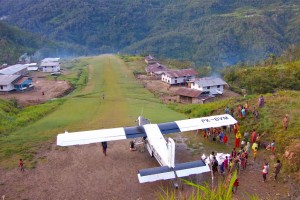 |
| Kegata with Apowo in the top-right of the frame (June 2013) |
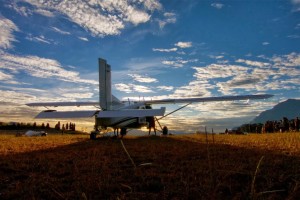 |
| Sunrise in Nabia (July 2013) |
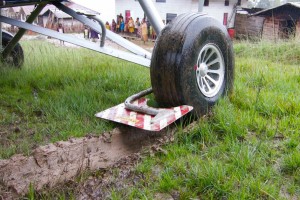 |
| Stuck in the mud at Kegata (July 2013) |
This past year has been the absolute best I’ve ever had. The flying I’m doing now is exactly what I’ve been looking for since I started in Indonesia and every day offers new challenges from dealing with the treacherous mountain weather to landing somewhere new to simply discovering a new flying technique. Papua is such an amazing place to be flying and the Porter thrives here. It’s exactly what it was designed to do and I truly love being able to fly it for what Pilatus built it for. And I simply can’t wait for the next few years!
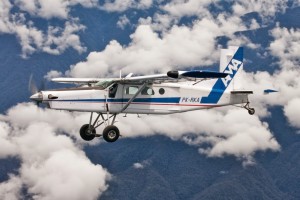 |
| Passing AMA Porter back into Timika (Nov 2013) |
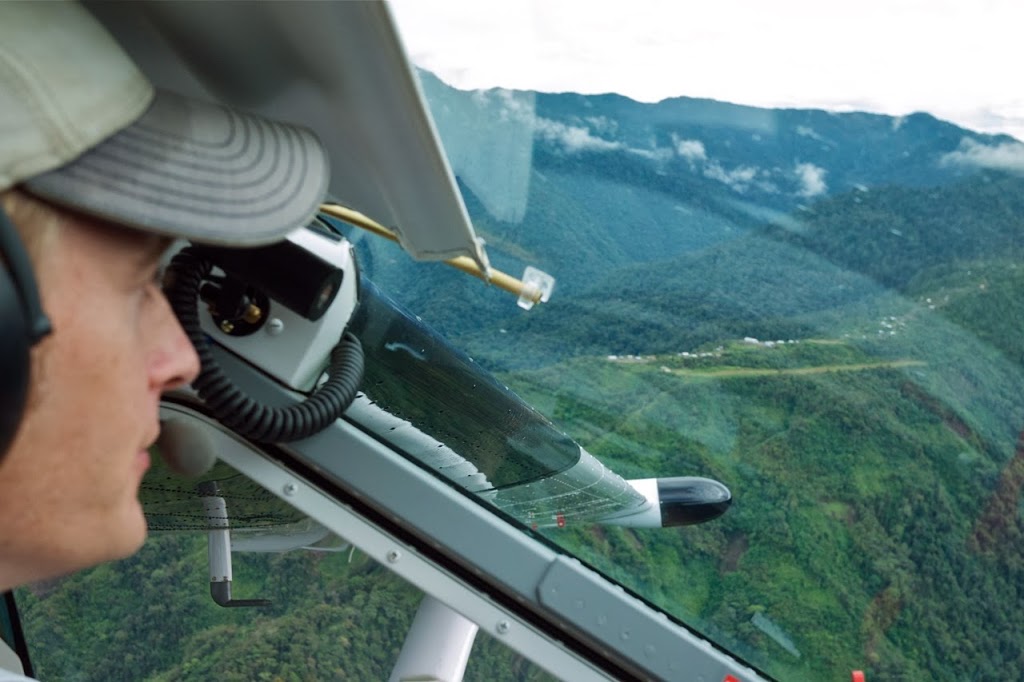
Thanks for your story 🙂 Looking forward for more updates about your bush flying experience with the fabulous Porter. Hope you have safe and fun flights 😉
Thanks David. Glad you’re enjoying the blog :o)
great enthusiasm!
Cheers!
Hey Matt, what kind of pilot’s licence do you need for a job like yours? I’m guessing a CPL?
Yes you do need a CPL to do commercial flying such as this. Our company also insists on pilots having an instrument rating too as the weather can require flying in IMC at times.
Hi Matt,
what is the average minimum hours required for someone to do bush flying? (considering one has a CPL, IR, ME, MCC, CFI) and do they prefer FAA or EASA?
I can only speak for the company I work for here in Indonesia which is an ICAO approved CPL with instrument rating (e.g. FAA, EASA, CASA etc.). Not sure what the minimum hours are now; there wasn’t one when I joined. Take a look at this blog for more details: http://susiairinterview.blogspot.com/
Kegata looks like a tougher version of Lukla 😉
i loved reading your story, this is making flying one of my favourite dreams
Cheers Bobtek! I reckon Lukla looks more like an airstrip here in Papua called Mulia which has a similar slope to it and is asphalt. I sometimes go to it but it’s usually visited by Caravans, Twin Otters or PC-12s.
Hello Matt, I saw your video courtesy of FlightAware then surfed over to your blog. I have been an avgeek for 50 years and you are truly living the dream. Well done you, and savour the days, young man. You will certainly have many, many thrilling tales to tell when grandchildren come along! Fly safe and I will check in from time to time. PK
Cheers Paul, I certainly will continue to savour my days out here! I’m hoping this blog will serve to remind me of the adventures although there are a few things I can’t put online just yet. I’ll save those for the book ;o)
A little break in the LRJT fuel planning ATPL syllabus….You are truly fueling the dream Matt. Thanks for taking the time to share all this, be safe and keep exploring.
Vincent
No worries Vincent, I know full well how tedious those ATPLs are! Stick at it as it does pay off in the end.
Wow Matt, I just can’t stop reading this blog! Very cool and thanks so much for taking the time to write about it. Well written too.
Godspeed,
Scott
You’re welcome Scott and thanks for the kind comments :o)
Hi Matt,
All going well I will be heading to papua in the New Year to fly a C208. Loving the videos and posts, they give a good look at the flying, thanks.
Might see you up there sometime
Cheers Duncan. I might well see you out here in the near future then! You’ll love it :o)
I am Indonesian and have never been to Papua! And I never know that a pilot’s blog can be this enjoyable. Thank you for sharing some challenging parts of Papua. Have a save flight!
Thanks Uswah, I’m glad you’re enjoying it and nice to hear from an Indonesian reading my blog.
As and Indonesian I really glad that you have alot of fun in our country, And adore our country so much 😀
I’ve a little bit question for you matt, is there any contract bond in Susi? especially when you fly Porter?
What usually your friend do after fly Porter? is there any chance to go work on the jet airliners without having jet time, just high TT?
If the question too personal you can ignore it 🙂